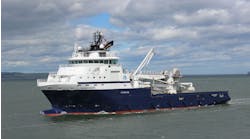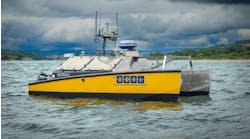Bruce Beaubouef • Houston
The demand for offshore floating production systems is exhibiting strong growth, according to a recent report by International Maritime Associates, Inc (IMA). According to the report, fourteen floating production units have been ordered over the past four months – a record pace reflecting strong underlying market drivers.
With regard to current inventory, IMA found that 256 floating production systems are in service or available worldwide. FPSOs comprise 62% of the inventory. The balance is comprised of production semisubmersibles (17%), tension leg platforms (9%), production spars (7%), production barges and FSRUs (5%). Of the total production floater inventory, 11 units are currently off field and available for reuse – making the effective utilization rate 95.7%.
Relating to recent orders, the report noted that that the 14 orders since March include the world's 1st FLNG system. At $3 billion, the Prelude FLNG system is the most expensive floating production unit ordered to date. Among the other orders are 9 FPSOs (1 purpose-built unit, 6 units converted from trading tanker hulls and 2 modification/redeployments); 2 production spars, and 2 purpose-built FSRUs. Total value of the 14 construction contracts exceeds $11 billion.
The report also noted that the current order backlog consists of 53 production floaters, a net increase of 6 units since March. This extends the buildup in backlog that began in second half 2009. Twenty-eight units utilize purpose-built hulls, while 25 are based on converted tanker hulls. Twenty units are being built for leasing operators; 33 directly for field operators.
IMA identified 196 projects in the bidding, design or planning stage that potentially require a floating production or storage system. These projects are declared discoveries or planned developments where a floating production or storage system is being considered as the development option.
Brazil is the most active region for future projects, with 50 potential floater projects in the planning cycle. Next in line is Southeast Asia with 37 projects; followed by West Africa with 36 projects; Northern Europe 22 projects; Gulf of Mexico 17 projects and Australia 11 projects.
Of the 196 planned projects, 53 are in the bidding or final design stage. Major hardware contracts for these projects are likely to be awarded within the next 12 to 18 months, the report said. Another 143 floater projects are in the planning or study phase. Major hardware contracts for these projects are likely in the 2013 to 2018 timeframe.
Drilling rigs for Russian arctic near completion
A team from Gazprom has visited the Vyborg Shipbuilding Plant in northern Russia to review progress on thePolyarnaya Zvezda and Severnoye Siyaniye semisubmersible drilling rigs.
Construction and acceptance testing have been completed for the rigs, both of which are scheduled to operate on the Russian shelf, including the Shtokman field in the Barents Sea.
Vyborg Shipbuilding Plant was awarded the construction contract in November 2007 by Gazprom subsidiary Gazflot.
The two rigs are designed to operate in severe natural and climactic conditions – they can withstand low temperatures, waves up to 32 m (105 ft) high, and perform exploratory and production drilling of gas and oil wells down to subsurface depth of 7,500 m (24,606 ft), and in water depths between 70 and 500 m (229-1,640 ft).
Shtokman is in the central part of the Russian sector of the Barents Sea. Its estimated reserves are 3.9 tcm (137.7 tcf) of gas and 56 MM tons (≈408 MMbbl) of gas condensate, most of which is within Gazprom's licensed area.
Keppel to deliver ultra- deepwater rig to Saipem
Keppel FELS says it is on track to deliverScarabeo 9, a sixth-generation ultra-deepwater semisubmersible drilling rig, to Saipem on time and with no lost time incidents.
The company says that a significant part of its workscope on the rig involved the completion and commissioning of marine and drilling systems onboard. The Frigstad D90 semisubmersible rig is equipped with a Dynamic Positioning 3 system and will be capable of operating in water depths of up to 3,600 m (11,810 ft).
Keppel's current projects for Saipem include the completion of a newbuild pipe laying vessel,Castorone, which is being jointly undertaken by Keppel Shipyard and Keppel Singmarine.
GSP to cooperate with AMEC, acquire vessel
Grup Servicii Petroliere (GSP) and AMEC have agreed to develop oil and gas exploration and production projects in the Black Sea area.
GSP operates a construction fleet that includes five mobile offshore drilling rigs, a modular drilling rig, 10 offshore support vessels of different types, a DP-3 pipelay barge, the largest heavy-lift crane barge in the Black Sea, a heavy-lift semisubmersible, and an offshore work and accommodation barge. It also owns and operates inspection class ROVs and a 300-m (984 ft) water depth saturation diving system.
GSP further strengthened its fleet this month by agreeing to buy the pipelay vesselAcergy Falcon from Subsea 7. The 153-m (502 ft) long, DNV-classed vessel is capable of installing rigid pipelines up to 14-in. (36 cm) diameter and also flexible flowlines and umbilicals. The vessel should be delivered in September, and will be renamed GSP Falcon.
The vessel sale moves forward the acquisition of Acergy by Subsea 7.
Offshore Articles Archives
View Oil and Gas Articles on PennEnergy.com





